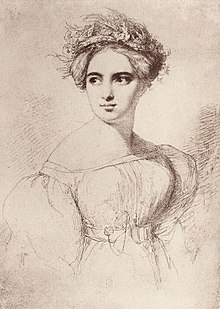Both Fanny Hensel’s origins and her legacy are impressive, to say the least. Her paternal grandfather, Moses Mendelssohn, was a famous philosopher and literary critic. Moses came from humble beginnings, but soon became well-known and respected in both Jewish and German society. He was an advocate for Jewish emancipation from discriminatory laws in Germany and is credited as one of the forces behind the “Jewish Enlightenment” (HaSkalah) in the late 18th century that ultimately worked to assimilate Jews into European society.
Moses’ son, Abraham, took this assimilation as far as he could: he converted to Protestantism and added a Germanic surname to try and distance himself from his father (and Judaism). His wife, Lea Mendelssohn (née Solomon), descended from the equally influential Itzig family. Lea’s grandfather, Daniel Itzig, was a banker for two kings of then-Prussia and as such, enjoyed a level of freedom and affluence which was rare among Jews at that time. Like Moses Mendelssohn, Itzig also worked to improve the state of the Jewish people and actually funded members of HaSkalah (including Moses’ teacher, Rabbi Israel of Zamosch).
Many of Daniel Itzig’s thirteen children were influential in German society, particularly in their roles as patrons of the arts – two of his daughters were patrons of Mozart, while his daughter Sarah (Itzig) Levy studied with Wilhelm Friedemann Bach and also had connections with Carl Philip Emmanuel Bach. Sarah left a collection of Bach manuscripts to the Sing-Akademie of Berlin, which her niece Lea would later join, as well as her grand-nephew Felix Mendelssohn and grand-niece Fanny Hensel (the heroine of our story…you may have been wondering when we’d get back to her).
Fanny married the painter Wilhelm Hensel in 1829 (whose portrait of her is featured on this page). Thankfully, Wilhelm did not share the Mendelssohn men’s insistence that Fanny give up music for housework and actually made it part of her daily tasks to sit at the piano every morning. Ironically, they only had one child who survived to adulthood: Sebastian Ludwig Felix Hensel. Sebastian’s numerous children included Paul Hugo Wilhelm Hensel and Kurt Wilhelm Sebastian, who each made important contributions to the sciences in philosophy and mathematics.
Given her extraordinary lineage and musical connections, one can’t help but wonder what Hensel might have accomplished if she hadn’t been born a girl. During her youth, Hensel received precisely the same education, musical and otherwise, as her brother Felix, yet society demanded that her sole profession must be a wife and mother. Yet, even with these restrictions, she still produced an astounding amount of music for such a short lifetime. Hensel wrote over 400 works in a wide variety of genres including Lieder, piano works, chamber music, and cantatas. She was one of the first women to compose a string quartet and she even composed the organ recessional for her own wedding in the span of just hours when her brother could not due to an injury.
From 1831 until her death, Hensel composed, arranged, and directed the music for her weekly salons, whose success did much to raise Berlin’s status as a musical hub. Through these salons and her travels, Hensel enjoyed acquaintances with many prominent musicians like Gounod, Vieuxtemps, Clara Schumann, and the critic Robert von Keudell, whom she consulted for musical advice when her brother Felix became more engrossed in his work. In fact, Hensel’s son credited von Keudell as being instrumental in her finally publishing a few of her compositions (under her married name) just before her death. In her dedication to the field and her musical sensitivity as a composer, it seems that Hensel was a professional musician in all but name.
Return to podcast. ↵
Can’t get enough?
Visit our Bibliography page for further sources.
Subscribe to our Newsletter!

